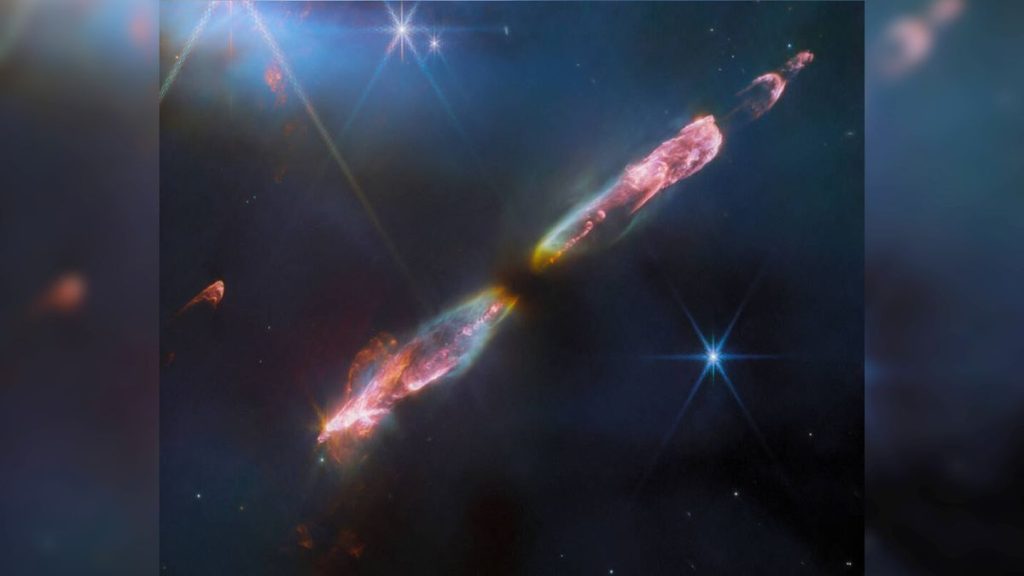The growing, sun-like protostar HH 211 shoots out a pair of luminous jets of gas and dust that form vibrant shockwaves as they collide with gas surrounding the baby star. (Image credit: ESA/Webb, NASA, CSA, T. Ray (Dublin Institute for Advanced Studies))
The James Webb Space Telescope (JWST) has spied a baby, sun-like star spewing out supersonic streams of gas and dust into space, triggering visually stunning shockwaves that researchers say “look like lightsabers.”
The newly formed star, or protostar, is not actually visible in the latest JWST photo. But scientists know it is located in the middle of the dark region between the two luminous rivers of outflowing gas and dust, known as bipolar jets, that stream from the growing stellar mass, named Herbig-Haro 211 (HH 211). (A Herbig-Haro object is a region of a nebula illuminated by a newborn star.)
HH 211 is located around 1,000 light-years from Earth in the Perseus constellation and was discovered in 1994. Based on the size of the jets, the protostar is likely only a few thousand years old and roughly 8% as massive as the sun, according to NASA. However, the mini star will grow to around the same size as the sun over the next few million years. This suggests that our own star may have once looked an awful lot like HH 211.
In a recent study, published Aug. 24 in the journal , researchers analyzed the new photo of HH 211 to determine what the jets are made of.
Related: 32 jaw-dropping James Webb Space Telescope images
A closer look at the luminous polar jets and the vibrant shockwaves they created. (Image credit: ESA/Webb, NASA, CSA, T. Ray (Dublin Institute for Advanced Studies))
The beams of matter can “shine with light from many different atoms and molecules” that get excited as they collide with the surrounding clouds of gas, study lead author Tom Ray, an astrophysicist at the Dublin Institute for Advanced Studies, said in a statement. But the JWST’s near-infrared camera makes it much easier to differentiate between the jets’ components, he added.
The infrared images suggest the jets are mostly made from molecules — two or more atoms connected by a chemical bond — including carbon monoxide, silicon monoxide and molecular hydrogen. This surprised the researchers, who expected that, like other bipolar jets, HH 211 would predominantly be made from individual atoms or ions.
The team believes that the jets stream molecules, instead of atoms and ions, because the material is flowing out relatively slowly. Faster speeds likely break molecules apart into their individual atoms and ions. It is “currently a mystery” why the jets of HH 211 are slower than other bipolar jets, Ray said.
Related: Can the James Webb Space Telescope really see the past?
Another noteworthy part of the new image is the “wiggling” tendrils of gas and dust located through the center of each jet’s base (the part nearest the protostar). This uneven distribution of matter, which is mirrored across both jets, could hint that the protostar has an unresolved binary star — another protostar with the potential to grow into a stellar companion, according to NASA. However, this hypothesis requires further investigation.
The level of detail JWST captured is unprecedented. The new photo has a spatial resolution that is between five and 10 times higher than any other image of HH 211, NASA noted. This is another example of how JWST can unlock further secrets of already well-studied cosmic structures, Ray said.
Last week, JWST also made headlines after spotting potential signs of extraterrestrial life on an exoplanet located around 120 light-years from Earth.

